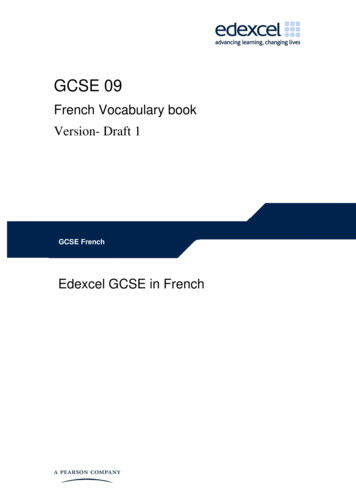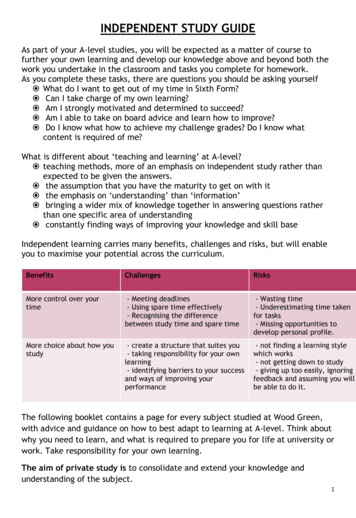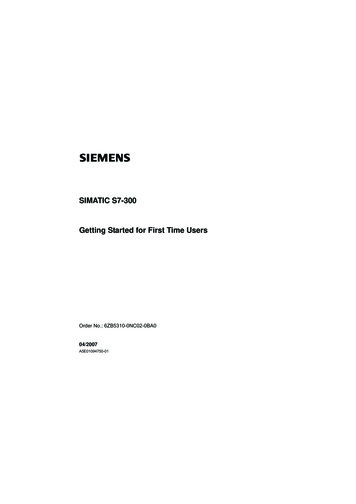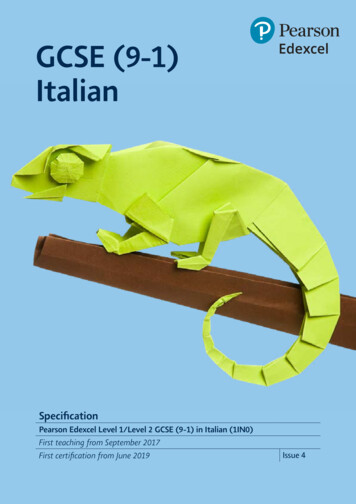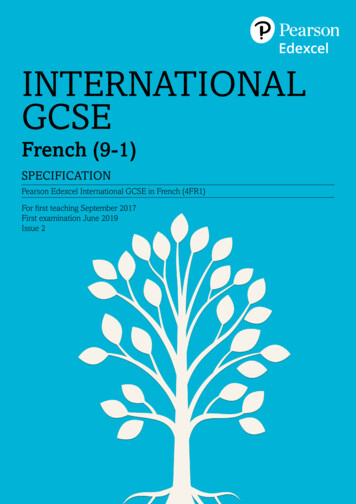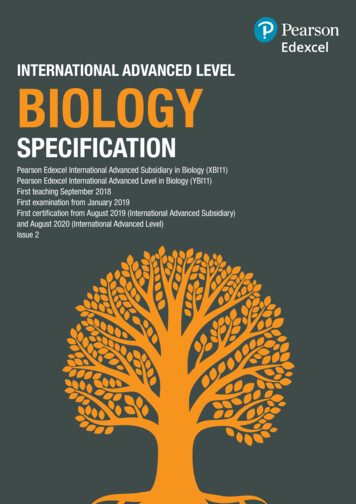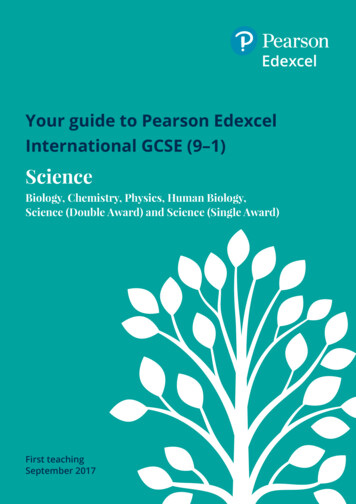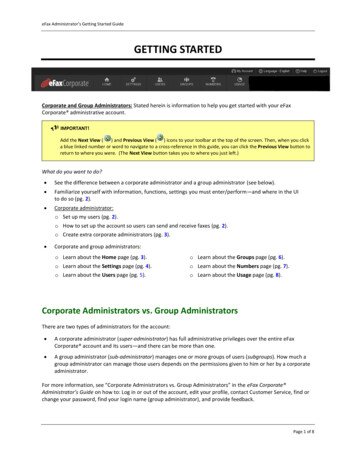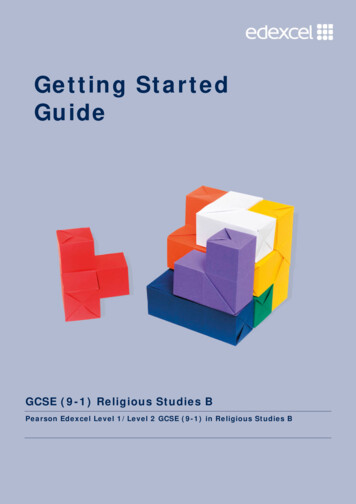
Transcription
Getting StartedGuideGCSE (9-1) Religious Studies BPearson Edexcel Level 1/Level 2 GCSE (9-1) in Religious Studies B
Contents1. Introduction2. What’s changed?2.1 What are the changes to the GCSE qualification?122Changes to GCSE Religious Studies content requirements2Changes to Assessment Objectives2Timeline and league table points2.2 Changes to the Edexcel specification34Two different GCSE Religious Studies specifications4Specified religions4GCSE Religious Studies Specification B Full Course overview4GCSE Religious Studies Specification B Short Course overview5Constructing a coherent course5Changes to specification content63. Planning3.1 Planning and delivering a linear course3.2 Delivery models for the full course3.3 Co-teaching the full and short courses4. Assessment guidance4.1 Assessment overview4.2. Part (a) questionsPart (a) ‘Outline’ questionsPart (a) ‘State’ questions4.3 Part (b) questions77710121213131414Part (b) ‘Explain’ questions14Part (b) ‘Describe’ questions4.4 Part (c) questions1517‘Explain’ for part (c) questions4.5 Part (d) questions1718Evaluate part (d) questions4.6 Spelling, Punctuation and Grammar18215. 9–1 grading22
1. Introduction1. IntroductionThis Getting Started guide provides an overview of the new GCSE Religious StudiesB Beliefs in Action specification, to help you get to grips with the changes tocontent and assessment and to help you understand what these mean for you andyour students.We will be providing a package of support to help you plan and implement the newspecification. Planning: In addition to the section in this guide, we are providing courseplanners and schemes of work that you can adapt to suit your department Additional specimen papers for some of the religions and options so that you canhave extra papers to use with students in preparing for the exams Student exemplar answers with examiner commentary.These support documents will be available on the GCSE 2016 Religious StudiesSpecification B page of the Pearson qualifications website. Pearson Education Ltd 2016.1
2. What’s changed?2. What’s changed?2.1 What are the changes to the GCSE qualification?GCSE Religious Studies specifications are changing for first assessment 2018: thesechanges therefore apply to all two-year courses from 2016 and three-year coursesfrom 2015. There will be a new 9-1 grading system, with 9 being the top level (see page23). There will be no coursework or controlled assessment components: allassessment, as now, will be through external examinations. There will be a fully linear structure, with all exams sat at the end of the course. GCSE Religious Studies qualifications will be untiered. There will be tiers in onlya small number of subjects, such as Maths.Changes to GCSE Religious Studies content requirementsThe content requirements for GCSE Religious Studies have been revised by the DfE.All awarding organisations’ specifications for GCSE Religious Studies must meetthese criteria.The key points from the content requirements are: Students must now study two religions from a choice of Buddhism, Christianityor Catholic Christianity, Hinduism, Islam, Judaism or Sikhism; previously schoolscould follow a single faith route. The subject criteria now contain more content and details of Areas of Study foreach religion. Specific philosophical, ethical and religious themes have been introduced. The subject criteria have been split into two parts (A & B) to allow specificationsto be designed with two different approachesoOne allows a 75/25 split between 2 religionsoOne allows a 50/50 split between 2 religionsThis Getting Started guide is for Specification B which has the 50%/50% split. (Fordetails of Specification A which has the 75%/25% split, please see the separateGetting Started Guide for Specification A.)Changes to Assessment ObjectivesThe GCSE Religious Studies Assessment Objectives have also been revised.AO150%AO250%2Demonstrate knowledge and understanding of religion and belief,including: beliefs, practices and sources of authority influence on individuals, communities and societies similarities and differences within and/or between religions and beliefsAnalyse and evaluate aspects of religion and belief, including theirsignificance and influence Pearson Education Ltd 2016.
2. What’s changed?Timeline and league table mer series asnormalLast assessmentNEW 2016specificationsFirst teaching oftwo-year course2018First assessment forfull course and shortcourseThe last available assessment of the current Religious Studies GCSEs will be June2017. Only the reformed GCSEs will be reported in the 2018 performance tables.Therefore, it is possible to enter Year 10 students for the 2017 summer series ofthe current GCSE, but the results for this Year 10 cohort will not count in theschool’s 2018 performance tables. Pearson Education Ltd 2016.3
2. What’s changed?2.2 Changes to the Edexcel specificationTwo different GCSE Religious Studies specificationsAs the new content requirements now allow awarding bodies to develop twoseparate qualifications to meet the needs of all schools, from 2016 we are offeringtwo separate Edexcel GCSE Religious Studies specifications. This guide is all aboutthe Edexcel GCSE Religious Studies Specification B which allows you to have equalfocus on two religions (50% on each).We offer both a full course qualification and a short course qualification for EdexcelGCSE Religious Studies B. This guide focuses primarily on the full course. Details ofthe short course can be found on the Pearson qualifications website and throughoutthis guide where applicable.Specified religionsThe DfE requirements state that two of the following religions must be studied: Catholic Christianity OR Christianity Islam Buddhism Judaism Hinduism SikhismFor Specification B (see table below), it is possible to study any combination of thereligions above – one for each paper choice – except both Catholic Christianity andChristianity.Entry codes for each paper and religion will be made available in the InformationManual. It is crucial that exams officers use the correct codes to ensure the rightexam papers are received.GCSE Religious Studies Specification B Full Course overviewThe GCSE Religious Studies Specification B builds on approaches from previousspecifications, allowing students to study two religions, integrated with the keyphilosophical and ethical issues facing the local, national and internationalcommunity. This specification allows beliefs, teachings and practices of tworeligions to be brought to life as well as exploring different viewpoints withinreligions. There are three papers – students study two of these three papers. All seven religions are offered for each paper. Students study one religion perpaper.Paper 1:50%Area of Study 1Four compulsory content areas based on the chosenreligionReligion andEthicsPaper 2:Area of Study 24Paper 1: Religion and Ethics50% Beliefs Marriage and the Family Living the Religious Life Matters of Life and DeathPaper 2: Peace and ConflictFour compulsory content areas based on the chosen Pearson Education Ltd 2016.
2. What’s changed?religionPeace and ConflictPaper 3:50%Area of Study 3 Beliefs Crime and Punishment Living the Religious Life Peace and ConflictPaper 3: Religion, Philosophy and Social JusticeFour compulsory content areas based on the chosenreligionReligion andPhilosophy Beliefs Religious Experience Living the Religious Life EqualityGCSE Religious Studies Specification B Short Course overviewThe short course is half the content of the full course. As for the full course,students must study two religions. Two papers are offered and students study onereligion in each paper. Each religion is covered equally. The religions offered are:Catholic Christianity OR Christianity, Islam, Judaism, Buddhism, Hinduism andSikhism.The short course has been designed so that it can be co-taught with the full course,as the content for the relevant sections is almost identical. More information on thiscan be found on page 10.Paper 1:50%Area of Study 1Two compulsory content areas based on the chosenreligionReligion andEthicsPaper 2:Area of Study 2Peace and ConflictPaper 1: Religion and Ethics50% Beliefs Marriage and the familyPaper 1: Peace and ConflictTwo compulsory content areas based on the chosenreligion Beliefs Crime and PunishmentConstructing a coherent courseFor GCSE Religious Studies Specification B, all seven religions are available in eachof the three papers offered. It is possible to ‘mix and match’ any paper and religionalthough it is NOT permissible to take Christianity and Catholic Christianity togetheras they do not count as two separate religions. For example, one possiblecombination is Paper 1: Religion and Ethics with Christianity and Paper 2: Peaceand Conflict with Islam.Some examples of how to plan the course can be found in Section 3 of this guide,as well as a wide selection of planners and schemes of work available on thewebsite. Pearson Education Ltd 2016.5
2. What’s changed?Changes to specification contentThe DfE published the content for GCSE Religious Studies which can be found ontheir website. The areas of content for each religion are listed here and can befound in the specifications.The overview table below indicates areas of broad content overlap between the2009/2012 Edexcel GCSE specification and the new 2016 specification. However itshould be noted that the new subject content defined by the DfE is significantlymore detailed, so it is crucial that the detailed content in the specification is readcarefully to ensure the new content is covered in the correct depth.2009/2012 Edexcel GCSE Specification2016 Edexcel GCSE SpecificationStudents take TWO of the following unitsStudents take TWO of three papersUnit 1: Religion and Life Based on a Study ofChristianity and at least one other religionPaper 1: Religion and Ethics BeliefsUnit 2-7: Religion and Life Based on a studyof Christianity/Roman m Marriage and the family Living the religious life Matters of life and death Believing in God Matters of life and death Marriage and the family Religion and community cohesionUnit 8: Religion and Society based on a studyof Christianity and at least one other religionPaper 2: Peace and ConflictThis unit covers: Beliefs Crime and punishment Living the religious life Peace and conflict Rights and responsibilities Environmental and medical issues Peace and conflict Crime and punishmentUnit 9-15: Christianity/Roman mAll these units cover the four topics of: Beliefs and values Community and tradition Worship and celebration Living the religious lifeUnit 16: Mark’s GospelThis unit covers: Discipleship Conflict and argument Death and resurrection The identity of Jesus6Paper 3: Religion, Philosophyand Social Justice Beliefs Religious experience Living the religious life EqualityThere is no direct overlap in contentwith this unit in Specification B, butall of the new papers containreferences to sources of wisdom andauthority. Mark’s Gospel is an optionin Specification A Paper 4. Pearson Education Ltd 2016.
3. Planning3. Planning3.1 Planning and delivering a linear courseThe new GCSE Religious Studies Specification B full and short courses are linearcourses which means that all papers must be sat at the end of the course.There are a number of ways to deliver the course and some options are laid outbelow in 3.3. These models, along with the planners on the website, are designedfor centres to adapt to their own circumstances and teaching methods.Some centres choose to start the GCSE course in Year 9. This still remains a validoption and there are a variety of 3-year planners on the website to help thedelivery of the course over both 2 and 3 years.As stated in Section 1 of this guide, the first assessment for the new GCSE will bein 2018. The last assessment for the current (2012) GCSE is summer 2017. Theresults from the last assessment in June 2017 will appear in the 2017 performancetables. ONLY the new full course GCSEs will count in the 2018 tables. The shortcourse does not carry any performance table points.3.2 Delivery models for the full courseThe top-level tables below suggest ways of splitting the content over either 2 yearsor 3 years and how much to cover in each week. There are a number of courseplanners available on the website which provide more detail. Note that thesuggested weeks available are likely to vary year on year due to Easter and otherreligious holidays.Example 2-year plan for GCSE RS Specification BThis example takes the same integrated approach as the course planners on thewebsite, with one section of each paper taught one after the other – so thatstudents learn about both religions each term. For a 2-year course taking thisapproach, it is suggested that one bullet point in each section is covered per week.Note that this example plan is for Paper 1 and Paper 2 but can easily be adapted forany choice of paper combinations.TermWeeks (approx.)Proposed content coverage7 weeksPaper 1: Section 1Year 10Autumn Term 1Content bullet points 1-7Autumn Term 27 weeksPaper 1: Section 1Content bullet point 8Paper 2: Section 1Content bullet points 1-6Spring Term 16 weeksPaper 2; Section 1Content bullet points 7-8Paper 1: Section 2Content bullet points 1-4Spring Term 26 weeks(dependent onEaster)Paper 1: Section 2Content bullet points 5-8Paper 2: Section 2Content bullet points 1-2 Pearson Education Ltd 2016.7
3. PlanningSummer Term 16 weeksPaper 2: Section 2Content bullet points 3-8Summer Term 26 weeksPaper 1: Section 3Content bullet points 1-6Year 11Autumn Term 17 weeksPaper 1: Section 3Content bullet points 7-8Paper 2: Section 3Content bullet points 1-5Autumn Term 27 weeksPaper 2: Section 3Content bullet points 6-8Paper 1: Section 4Content bullet points 1-4Spring Term 17 weeksPaper 1: Section 4Content bullet points 5-8Paper 2: Section 4Content bullet points 1-3Spring Term 2Summer Term 1Summer Term 26 weeks(dependent onEaster)Paper 2: Section 46 weeksRevisionContent bullet points 4-8Start revisionExaminationsAn alternative approach would be to teach one paper/religion per year, starting thesecond paper in the summer term of Year 10 to allow sufficient time for revision inYear 11.Autumn termPaper 1 Section 1 bullet points 1-8Paper 1 Section 2 bullet points 1-6Spring termPaper 1 Section 2 bullet points 7-8Paper 1 Section 3 bullet points 1-8Paper 1 Section 4 bullet points 1-2Summer termPaper 1 Section 4 bullet points 3-8Paper 2 Section 1 bullet points 1-6Autumn termPaper 2 Section 1 bullet points 7-8Paper 2 Section 2 bullet points 1-8Paper 2 Section 3 bullet points 1-4Spring termPaper 2 Section 3 bullet points 5-8Paper 2 Section 4 bullet points 1-8Summer term8Revision and examinations Pearson Education Ltd 2016.
3. PlanningExample 3-year plan for GCSE RS Specification BThis example takes the same integrated approach as the course planners on thewebsite, with one section of each paper taught one after the other. For a 3-yearcourse following this approach, it is suggested that each bullet point is covered in1.5 weeks, so that each section is covered in 12 weeks. This means one section istaught per term, with two additional weeks in the autumn term that can be used foran introduction in Year 9 and a recap in Years 10 and 11. Note that this exampleplan is for Paper 1 and Paper 2 but can easily be adapted for any choice of papercombinations.TermApproximateProposed content coveragenumber of weeksYear 9Autumn Term14 weeksPaper 1: Section 1Spring Term12 weeksPaper 2: Section 1Summer Term12 weeksPaper 1: Section 2Autumn Term14 weeksPaper 2: Section 2Spring Term12 weeksPaper 1: Section 3Summer Term 212 weeksPaper 2 Section 3Autumn Term14 weeksPaper 1: Section 4Spring Term12 weeksPaper 2: Section 4Summer Term6 weeksRevision and examinationsYear 10Year 11 Pearson Education Ltd 2016.9
3. Planning3.3 Co-teaching the full and short coursesThe short course is designed to be taught alongside the full course for Paper 1 andPaper 2. (There is no Paper 3 in the short course.) The same range of religions isoffered as for the full course and the short course covers the following twocompulsory content areas based on the chosen religion:Paper 1: Religion and Ethics Beliefs Marriage and the familyPaper 1: Peace and Conflict Beliefs Crime and PunishmentIt is therefore entirely possible to teach these two topics for each religion firstbefore deciding if your students will sit the full course or the short course.Within each paper there is one important difference in the content for the shortcourse from the equivalent content for the full course. In order to ensure that theDfE requirement for philosophical and ethical arguments are fully met in the shortcourse, within the Beliefs section for each religion there is one point introducingphilosophical arguments. The relevant point is highlighted in the table below foreach religion.When co-teaching short course alongside full course, the most practical way tomeet the demands of both specifications is to teach the short course content to allstudents. Although full course students will not have specific questions on theadditional content, it can be used to help answer (d questions and will providecontext and arguments that will enhance student understanding.CatholicChristianity1.8* Catholic beliefs about eschatology: life after death; the nature ofresurrection, judgement, heaven, hell and purgatory, including referenceto John 11:17–27 and 2 Corinthians 5:1–10; philosophical arguments usedto support a Catholic understanding of life after death; divergent Christianbeliefs about life after death, with reference to purgatory and the nature ofresurrection; why belief in life after death is important for Catholics today.Christianity1.6* Christian eschatology: divergent Christian teachings about life afterdeath, including the nature and significance of resurrection, judgement,heaven, and hell and purgatory, with reference to the 39 Articles ofReligion and Catholic teachings; and philosophical arguments used tosupport a Christian understanding of life after death; how beliefs about lifeafter death are shown in the Bible, including reference to 2 Corinthians5:1–10 and divergent understandings as to why they are important forChristians today.Islam1.8* Akhirah: Muslim teachings about life after death; the nature ofjudgement, paradise and hell; how they are shown in the Qur’an, includingSurah 17: 49–72; philosophical arguments used to support a Muslimunderstanding of life after death; divergent ways in which Muslimsteachings about life after death affect the life of a Muslim today.Buddhism1.5* Third Noble Truth including reference to theDhammacakkappavattana Sutta: the nature of nirodha and the cessationof tanha; Buddhist teachings about the ending of desire; the nature of thecycle of samsara; different understandings of nibbana and enlightenmentand their importance for Buddhists today; philosophical arguments used tosupport a Buddhist understanding of life after death.10 Pearson Education Ltd 2016.
3. PlanningHinduism1.5* The nature of the individual and life within Hinduism: the nature andimportance of the atman (eternal self), karma, the cycle of samsara,moksha; divergent Hindu understandings of the nature of the individualand life, including interpretations of Brihadaranyaka Upanishad 4.4 andphilosophical arguments used to support a Hindu understanding of lifeafter death; why beliefs about the atman, karma, samsara and moksha areimportant for Hindus today.Judaism1.8* Jewish beliefs about life after death: divergent Jewish understandingsof the nature and significance of life after death including reference todifferent forms of Orthodox and Reform Judaism; Jewish teachings aboutlife after death including interpretations of Ecclesiastes 12; the nature ofresurrection and judgement and philosophical arguments used to support aJewish understanding of life after death; why belief in life after death maybe important for Jews today.Sikhism1.4* Sikh beliefs about life after death: the nature of karma, rebirth andmukti (liberation); how they are shown in the Guru Granth Sahib, includingreference to Guru Granth Sahib 2, 11 and 78 philosophical arguments usedto support a Sikh understanding of life after death; divergentunderstandings of how and why karma, rebirth and mukti are importantfor Sikh life today. Pearson Education Ltd 2016.11
4. Assessment guidance4. Assessment guidance4.1 Assessment overviewStudents sit two papers, each worth 50% of the qualification. Both exams are1 hour 45 mins and worth 102 marks.All papers follow the same pattern of question types. Each paper has one questionon each area of specification content: in the full course, students answer fourquestions in each paper; in the short course, students answer two questions ineach paper. Each question is split into 4 parts (a)-(d).Full course structure for all papersQuestionMarksAssessment objective1(a)3AO11(b)4AO11(c)5AO11(d)12 3 b)4AO13(c)5AO13(d)12 3 SPaGAO24(a)3AO14(b)4AO14(c)5AO14(d)12AO2Short course structure for both papers12QuestionMarksAssessment objective1(a)3AO11(b)4AO11(c)5AO11(d)12 3 SPaGAO22(a)3AO12(b)4AO12(c)5AO12(d)12AO2 Pearson Education Ltd 2016.
4. Assessment guidance4.2. Part (a) questionsPart (a) is worth 3 marks. It assesses AO1 and tests knowledge of religion or beliefby recalling factual information.Part (a) questions will follow one of two formats: Outline three. State three.Part (a) ‘Outline’ questionsThese questions will ask students to outline three different elements; these couldbe features, elements, beliefs, responses, teachings etc.The command word ‘Outline’ requires students to provide knowledge of religion andbelief by recalling factual information. Therefore, for this response, students arerequired to write three sentences to outline the pieces of information required bythe question. They are not required to add any extra detail such as development,description or added examples or quotations.These questions will be marked using a points-based mark scheme. The one belowis for Paper 1: Christianity, Q2(a) in response to the question:Outline three Christian beliefs about marriageAll of the ‘Outline’ questions for both the full and the short course will follow a verysimilar pattern.There is always a clear instruction abouthow marks should be awarded. These canalso be used to advise students that theyneed three separate and different points.QuestionnumberAnswer2(a)AO1 3 marksThe mark scheme willalways state howmany marks areawarded for each AO.Award one mark for each point identified up to amaximum of three. Marriage is a sacrament which blesses the unionof two people (1)Marriage is the proper place to have sex (1)Marriage is a demonstration of love andcommitment (1)Marriage is the place to have and raise Christianchildren (1)Accept any other valid responses3The mark scheme will providemore than 3 possible responsesand instruct that any other validresponses should be accepted. Pearson Education Ltd 2016.13
4. Assessment guidancePart (a) ‘State’ questionsThese part (a) questions require students to recognise other religious traditions inGreat Britain. The command word ‘State’ also requires students to provideknowledge of religion and belief by recalling factual information. Therefore, for thisresponse, students will be required to state three different religions, other than theone they have studied, in Great Britain. As with the ‘Outline’ questions, they are notrequired to provide any extra detail.These questions will be marked using a points-based mark scheme. The one belowis for Paper 1: Catholic Christianity, Q1(a) in response to the question:State three religious traditions, other than Christianity, in Great BritainAll of the ‘State’ questions for both the full and the short course will follow a verysimilar pattern.QuestionnumberAnswer1(a)AO1 3 marksMarkAward one mark for each point identified up to amaximum of three. Judaism (1)Islam (1)Buddhism (1)Sikhism (1)Hinduism (1)3Again there is an instruction as to how marks should be awarded, which can also beused to advise students that they need three separate and different religions togain all three marks. Note here that the acceptable responses are the mainreligions of Great Britain.4.3 Part (b) questionsPart (b) is worth 4 marks. It assesses AO1 and tests knowledge of religion or beliefby recalling factual information.They will follow one of two formats: Explain two. Describe two.Part (b) ‘Explain’ questionsThese questions will ask students to explain two elements. These could be ways,reasons etc.The command word ‘Explain’ requires students to provide knowledge of religion andbelief and develop this beyond a habitual response. Therefore, for this response,students are required to give two reasons and then demonstrate a higher level ofunderstanding by developing this reason. The development must address thequestion and link clearly with the reason given, supplying more information aboutthe question asked. Students need to give one reason and develop this reason andthen give a second, different reason and develop this in a different way from thefirst reason.These questions will be marked using a points-based mark scheme. The one belowis for Paper 2: Islam, Q1(b) in response to the question:Explain two reasons the five roots of ‘Usul ad-Din’ are important for Shi’aMuslims14 Pearson Education Ltd 2016.
4. Assessment guidanceAll of the ‘Explain’ questions for both the full and the short course will follow a verysimilar pattern.The marking instruction indicatesthat students need to give tworeasons and develop both reasonsto gain the marks.QuestionnumberAnswer1(b)AO1 4 marksRejectAward one mark for providing areason. Award a second mark fordevelopment of the reason. Up to amaximum of four marks. They are the five principles offaith (1) they show a person whatthey must believe to be a MuslimThey come from the teachings ofthe Qur’an (1) for example Surah112 says “He Allah is one”They are the beliefs that Muslimsmust hold if their practices are tobe correct (1) they ensure thatthe practices that they teach arethe correct ones (1) Repeatedreason/judgement Rejectdevelopment thatdoes not relateboth to the reasongiven and to thequestionMarkAccept any other valid response4This column has instructionsto reject repeated reasons ordevelopments, ordevelopments not linked toboth the reason and thequestion.The bullets here are split into two.The first part exemplifies reasonsstudents might give in response tothe question.The second part of the bullet is thedevelopment students may provideto support the reason.Part (b) ‘Describe’ questionsOne of the DfE content requirements is that students study one chosen religionwithin the context of the wider British society whose religious traditions are, in themain, Christian.This means that, in some part (b) questions, students will need to compare andcontrast two areas of belief and practice within other religions with those areas inChristianity. The two areas of content where this is a requirement are marked withasterisks (*) in the specification.These questions will ask students to describe two differences between the religionthe paper is assessing and the main religious tradition of Great Britain. On the Pearson Education Ltd 2016.15
4. Assessment guidanceChristianity papers, this question will ask students to describe two differencesbetween Christianity and another religion they have studied.The command word ‘Describe’ requires students to provide an understanding ofreligion and belief and contrast with that of another. Therefore, for this response,students are required to give two relevant beliefs/practices from the religion thepaper is assessing and then two contrasting descriptions from a Christian tradition.The development must address the question and contrast clearly with the belief orpractice identified in the first part of the response, supplying more informationabout the question asked. Students need to describe one belief/practice andcontrast this belief/practice from the other religion and then give a second,different belief/practice and contrast this in a different way from the firstdescription.These questions will be marked using a points-based mark scheme. The one belowis for Paper 1: Islam, Q3(b) in response to the question:Describe two differences in forms of worship between Islam and otherforms of the main religious tradition of Great BritainAll of the ‘Describe’ questions will follow a very similar pattern.QuestionnumberAnswer3(b)AO1 4 marks Students are required to recognise thatChristianity is the main religioustradition of Great BritainRepeatedreason/judgement Rejectdevelopmentthat does notrelate both tothe reasongiven and tothe questionAward one mark for describing arelevant Christian belief/practiceAward a second mark for a contrastingdescription from the named religion. Upto a maximum of four marks Muslims must wash beforeworship (1) Christians are notcommanded to prepare forworship by washing (1)Muslims have prescribed timesfor worship (1) Christians cangenerally choose their owntimes for communal worship (1)Muslims worship facing Makkah(1) whereas in most ChristianChurches worshippers face East(1)Accept any other valid responseRejectMark4The mark scheme indicates that students need to recognise that Christianity is themain religious belief and that they need to give two relevant beliefs/practices withtwo contrasting Christian traditions.The bullets here are split into two: the first part exemplifies Islamic belief/practice.The second part of the bullet is the contrasting Christian tradition.16 Pearson Education Ltd 2016.
4. Assessment guidance4.4 Part (c)
There are three papers - students study two of these three papers. All seven religions are offered for each paper. Students study one religion per paper. Paper 1: Area of Study 1 Religion and Ethics 50% Paper 1: Religion and Ethics Four compulsory content areas based on the chosen religion Beliefs Marriage and the Family


